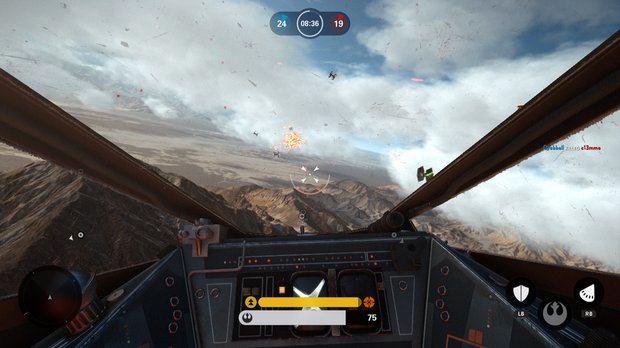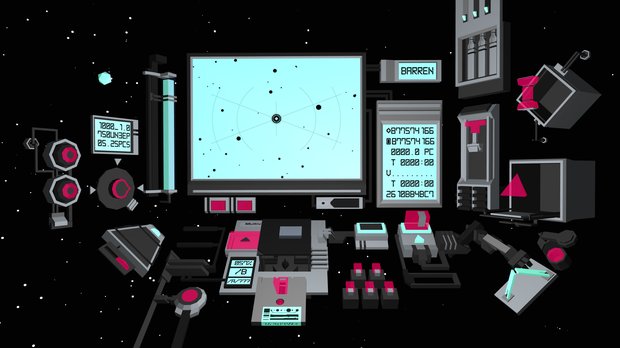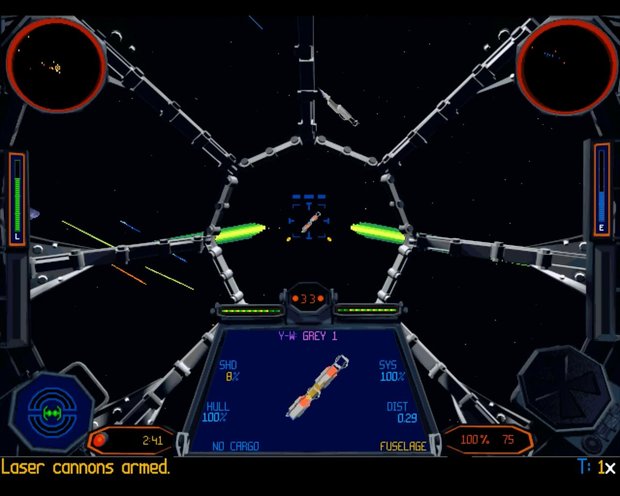Button-mashing: Why I can't truly love Star Wars Battlefront's air battles
As a child, I remember being repeatedly read a short book about a little girl who locked herself in a plane cockpit and started pushing all the buttons. I think it was used to teach me that while some actions may be exciting, that doesn’t mean you should perform them, and I thank the author for that knowledge - to this day, I’ve mostly avoided using my dog like a horse, scaring policemen, or rolling up and smoking literally everything I find on the ground.

Unfortunately, the book did not dissuade me on a literal level. Buttons remain a key part of my psyche, little unknowable nubs that forever pique my interest. You know when you find a switch in a new house, and you can’t work out what it’s for? This will preoccupy me for weeks. It’s a good thing phones became touchscreen-oriented as I hit adulthood, or I would be forever losing friends by reaching into their palms with my big, big curious fingers and accidentally dialling their ex-partners.
What I’m saying is that I empathise with that little girl - in the face of what I’ll call Grotesque Haptic Gentrification, the plane cockpit has remained stubbornly, delightfully button-filled, a big tin bowl of prods, cranks, tweaks and full-on palm-push “let’s go!” thumps. There’s a fairly good chance I will be shot in my lifetime, because the desire to see what the big red one under a flip-up sheath does will be simply too much for me to bear while on a transatlantic flight.
In the realm of games, a cockpit is a seductive red flag to my no doubt psychosexual button-honking bull - it generally signals that a game will offer something more complex than the average fare, and it will almost always do so through more buttons.

When MechWarrior 3 was too complicated for a friend and I to play alone, we took dual roles, Pacific Rim-style, he on aiming and firing duties, while I haphazardly punched the keyboard to keep our fat bipedal tank running. Later in life, I played the beautiful, weird MirrorMoon EP, a game whose entire opening section is spent working out how a chunkily futuristic, unlabelled cockpit works (by just pressing everything). Shamefully, I quickly lost interest once the game’s exploration extended beyond my little space car’s controls.
And so it was that I turned on Star Wars Battlefront’s aerial-only Fighter Squadron mode, switched to cockpit view, and discovered the spartan realities of DICE’s dogfighting. I don’t blame it, honestly. I understand why a game designed around accessibility to curious Star Wars fans as much as it is for seasoned online murderers might not want to copy Elite Dangerous’ (beautiful, distracting) multiple command consoles just to get their Snowspeeders to shoot straight.
And, to be fair, they are some lovely-looking cockpits - X-Wings are crammed with injection-moulded plastic, like souped-up, soaring 1982 Volkswagen Polos, while TIE Fighters’ faceted windows make you feel like you’re shooting around in a big spider’s eye, firing lasers out of its big spider eyelashes. The act of flying is pretty great, too - freed of the tiny targets you’re faced with in the likes of Walker Assault mode, Fighter Squadron creates big, rangy sky battles to get stuck into - once you’ve levelled up a little, you’ll start to be matchmade with fighter aces that can turn single kills into thrilling, minute-long affairs that switch from chases to escapes and back in the sweep of an aileron.
Weekly digests, tales from the communities you love, and more

And yet the fact that I don’t see a big futuro-Hugo Boss glove slam down on a big red button and hear a childish “wheeeee” when I press the boost button in a TIE Interceptor still rankles a little. You don’t even have control over opening and closing an X-Wing’s fanning prongs, which seems like it might be an actual fireable offence to me. Star Wars does so much to convince us that its universe is tangible - that everything in it could actually work, that I could press this and that would happen - that seeing its designs used as a simple veneer feels a little wrong.
Fighter Squadron created an itch too strong for it to scratch, which led me to the depths of GOG.com, where I downloaded classic DOS space fighter, Star Wars: TIE Fighter - a game I’d only ever heard about in hushed tones from wizened old games writers fused to their office chairs like crumb-strewn Ents. Just playing through its combat training missions showed how far DICE could have gone.
TIE Fighter is famously tough, and complex to the point of being laughable. It utilises almost an entire keyboard, then resorts to Shift commands to fit everything else it wants on your substandard, non-Galaxy-Far-Away tech. As expected, I ended up ignoring the clipped tones of my TIE driving instructor and just pressing everything - I can alter the charge speeds of my weapons, manually assign targeting computer commands, even peer through every one of those spider-eye windows individually, to get a better view of the unfathomable blackness of space.

You get a real sense of this being a proper, functional ship you’re getting to know, seeing which dials and meters flash and alter as you jab at controls. I was suddenly that kid in my book, right down to causing what was very probably a very major incident in the spaceport, and (presumably) leading the Stormtrooper equivalent of the transport police to get quite twitchy.
It’s fascinating, and quite probably unnecessary. But this 22 year-old game cuts to the heart of the excitement at being in charge of something in a way that DICE simply hasn’t. Even if the minutiae of weapon cooldown systems don’t matter in the grand scale of a dogfight, the idea of taking control of one of Battlefront’s 3D-scanned mega-props and having some measure of control over its many moving parts - seeing its switches flicked and its stoppers pulled - would offer an extra layer of fantastical authenticity.
Far from just pleasing me - an obvious pervert - this is exactly the feeling DICE has aimed for all the way down the line, to create a game that lets its players live inside the world Star Wars communicates, just for a little bit. What easier way than with the press of a button?



